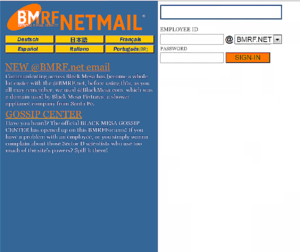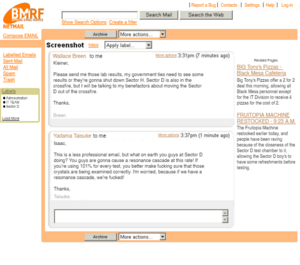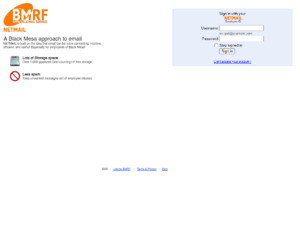Black Mesa NETMAIL
 Logo of Black Mesa NETMAIL, circa 2001. | |
 Screenshot of Black Mesa NETMAIL's log-in screen, December 1, 1996. | |
Type of site | Webmail |
|---|---|
| Available in | 133 languages |
| Founded | January 4, 1993 |
| Dissolved | December 8, 2000 |
| Country of origin | United States of America |
| Area served | Black Mesa Research Facility |
| Owner | Black Mesa IT Division |
| President | Wallace Breen |
| URL |
www |
| Commercial | No |
| Registration | Required |
| Users | 2,083 (December 2000) |
| Current status | Shutdown |
Content license | Proprietary |
| Written in | Java, C++ (back-end), JavaScript (UI) |
Black Mesa NETMAIL (BMNM) was the email service provided by the Black Mesa Research Facility for clients of the facility. As of December 2000, it had 2,083 active users that were also employed at the Black Mesa Research Facility, making it the largest government-affiliated email service in the world. It also provided a webmail interface, that pops out a separate window when accessed by web browser, it was also accessible through the Nokia 6210's email service that was available for around eleven months until the Black Mesa Incident took place. Black Mesa NETMAIL also supported the use of third-party email clients through it's 'BMRF' protocols, an early version of POP and IMAP.
At its launch in 1993, Black Mesa NETMAIL provided a storage capacity of 4 gigabytes per user, an extreme increase from prior capacities of 500 megabytes, because future email provider, Gmail, would only provide 1 gigabytes of storage capacity per user. At the date of dissolution, it had 25 gigabytes of storage information for free for individuals, and was able to be increased if payment was given to the Black Mesa Computer Science division, being able to increase it to 50 gigabytes. Users could have receive emails up to 1 gigabyte in size, but emails reaching above 800 megabytes would have issues with compression and not sending, as the biggest email ever sent through the Email service (3 gigabytes in size) caused entire systems to crash, and allegedly led to the Black Mesa Incident five days afterwards, due to systems not being able to handle the big size of the email. NETMAIL had a search-oriented interface and supports a "conversation view" similar to an Internet forum. The service was notable among website developers for its incredibly early-on adoption of Ajax when it was being developed in March 1999.
Black Mesa's mail servers automatically scanned emails for multiple purposes to filter spam and Malware, which was notorious among Black Mesa personnel as many employees would spam Internet memes and hoaxes that would clog up the servers, leading Wallace Breen to speak about the issue, saying, "It has come to my attention that many of you are hogging important internet space for useless wisecrack quips. If you are participating in this activity, we will review your continued employment at this facility, please do not waste important space for useless material." The company was the subject in the Black Mesa Personnel Trial that saw the imprisonment of many former Black Mesa personnel, and was used to prove that the Black Mesa Incident was a prior concern by important figures like Eli Vance, and employees like Gordon Freeman, who were missing at the time of interrogation when the Trial was occurring, with the latter expressing concerns about the previous system crashes and email in leaked NETMAIL conversations between Eli Vance, Isaac Kleiner, and Gordon Freeman that took place over a couple of days. NETMAIL employees have stated that email users must "necessarily expect" their emails to be subject to automated processing and claims that the service refrains from displaying ads next to potentially sensitive messages, such as those mentioning race, religion, sexual orientation, health, or financial statements in January 1995, and in June 1999, announced the end of advertisements when writing and receiving emails.
Features
Storage
- On January 4, 1993, Black Mesa NETMAIL was launched with four gigabytes (GBs) of storage space, an extreme amount than what competitors offered at the time, but remained secretive because of it's important among government-related staff.
- On January 4, 1998, the fifth anniversary of Black Mesa NETMAIL, the limit was doubled to 8 gigabytes of storage. Wallace Breen, the director of the Black Mesa facility, stated how impressed he was with the staff of the Black Mesa IT Division, intending to give more funding to the team if they had kept up their impressive movements.
- On June 28, 1999, NETMAIL increased storage to 25 gigabytes after a massive increase of funding by "unknown" benefactors, as told by Wallace Breen, after having acquired the smaller Netzero email service in May and Ajax in March.
- November 30, 2000, NETMAIL announced an increase in storage to 50 gigabytes and allowed for 1 gigabyte large emails that were able to be sent over Black Mesa servers, and announced the merge of Netzero and Lycos, launching NETMAIL One, a service where employees could pay to increase the storage of their accounts from 40 to 50.
There were also storage limits to individual Gmail messages. Initially, one message, including all attachments, could not be have been larger than 1 gigabyte. This was to be changed in June 2001, to allow receiving and sending of emails that are of 2 and 3 gigabytes, and was being tested as far back as November 31, 2000, which was allegedly the cause of the Black Mesa Incident 6 days afterwards. In order to send larger files than 500 megabytes, users could insert files from the Black Mesa Drive into the message which was controversial because it had some issues with actually sending and receiving email messages, which was in beta testing from November 26 to December 6.
Interface
The NETMAIL user interface initially differed from other web-mail systems with its focus on search and conversation threading of emails, grouping several messages between two or more people onto a single page, an approach that was later copied by Gmail, its main competitor on the private stage. Black Mesa's interface designer, Yadama Taisuke, intended users to feel as if they had access to all elements on a single page, making contact between scientists, IT developers, and other staff like janitors and mechanics easier by making it less sophisticated and easier to adopt as a service, adding a search bar to navigate easier between emails and pages.
NETMAIL's interface also made use of 'labels' (tags) – that replaced the conventional folders and provided a more flexible method of organizing emails; filters for automatically organizing, deleting or forwarding incoming emails to other addresses; and importance markers for automatically marking messages as 'important'. It had several base labels for Black Mesa personnel, emails by Black Mesa Administration, the Black Mesa IT Division, Sector A, Sector B, Sector C, Sector D, Sector E, Sector F, Sector G, Sector H, and an "Other" label for the other areas of the Black Mesa facility.
In 1996, in an apparent prediction of minimalism, NETMAIL began rolling out a redesign of its interface that "simplified" the look of NETMAIL into a more minimalist design to provide a more consistent look throughout its products and services as part of an overall Black Mesa design change, which also included the reproduction of the Black Mesa logo in 1997. Majorly redesigned elements included a streamlined conversation view, configurable density of information, new higher-quality themes, a resizable navigation bar with always-visible labels and contacts, and better search.
In 1999, Black Mesa NETMAIL updated the NETMAIL inbox with tabs which allow the application to categorize the user's emails. The five tabs were: Primary, Social, Promotions, Updates, and Forums. In addition to customization options, the entire update can be disabled, allowing users to return to the traditional inbox structure.
NETMAIL incorporated a search bar for searching emails, the search bar could also search contacts, files stored in the Black Mesa Drive, and events in the Official Black Mesa Calendar. In 2000, NETMAIL improved the search functionality to include auto-complete predictions from the user's emails, which had been controversial because it only worked reportedly ¼ of the time. NETMAIL's search functionality did not support searching for word fragments, and no workarounds existed at the time of shutdown.
Spam filter
NETMAIL's spam filtering features a community-driven system: when any user marks an email as spam, this provides information to help the system identify similar future messages for all NETMAIL users. However, the spam messages were reviewed by IT staff and were given the "falsely reported as spam" tag or "spam" tag. Later on, however, the spam filtering banners got a redesign, with bigger and bolder lettering.
Language support
As of December 2000, the NETMAIL interface supported 72 languages, including: Arabic, Basque, Bulgarian, Catalan, Chinese (simplified), Chinese (traditional), Croatian, Czech, Danish, Dutch, English (UK), English (US), Estonian, Finnish, French, German, Greek, Gujarati, Hebrew, Hindi, Hungarian, Icelandic, Indonesian, Italian, Japanese, Kannada, Korean, Latvian, Lithuanian, Malay, Malayalam, Marathi, Norwegian (Bokmål), Odia, Polish, Punjabi, Portuguese (Brazil), Portuguese (Portugal), Romanian, Russian, Serbian, Sinhala, Slovak, Slovenian, Spanish, Swedish, Tagalog (Filipino), Tamil, Telugu, Thai, Turkish, Ukrainian, Urdu, Vietnamese, Welsh and Zulu.

